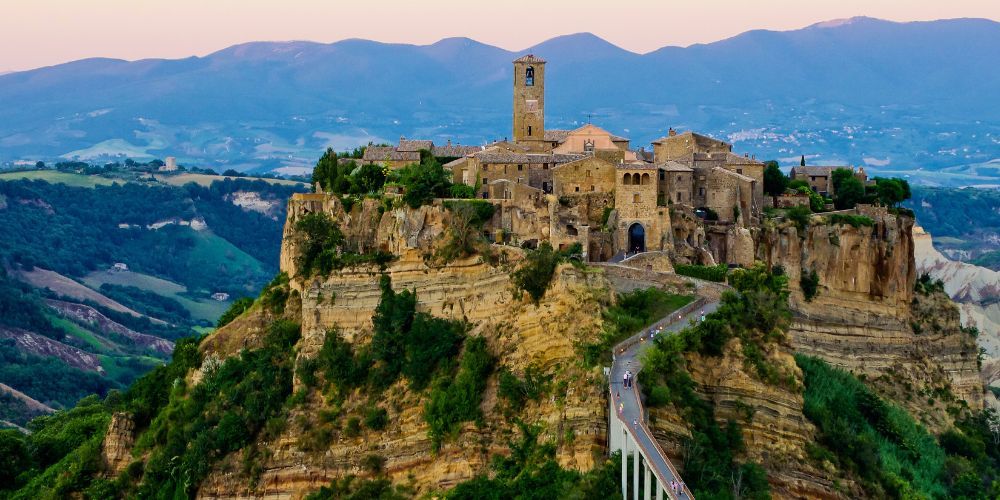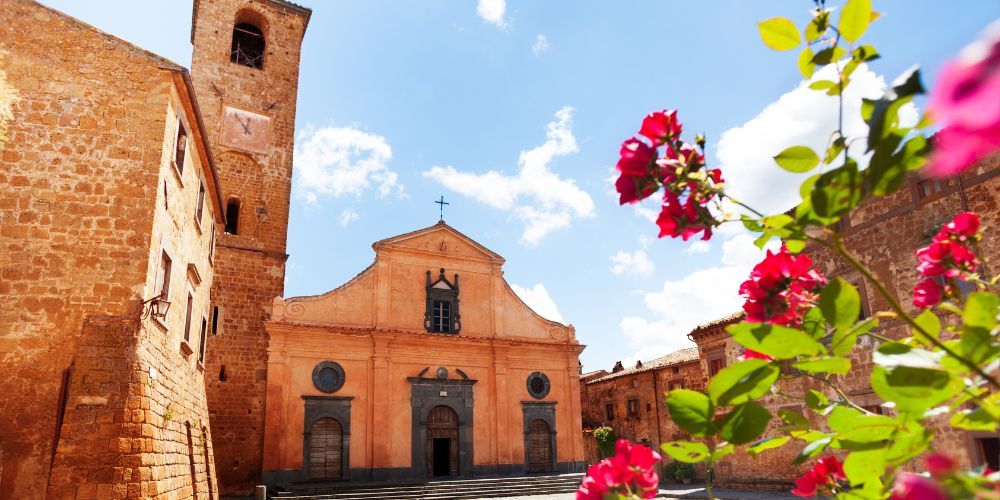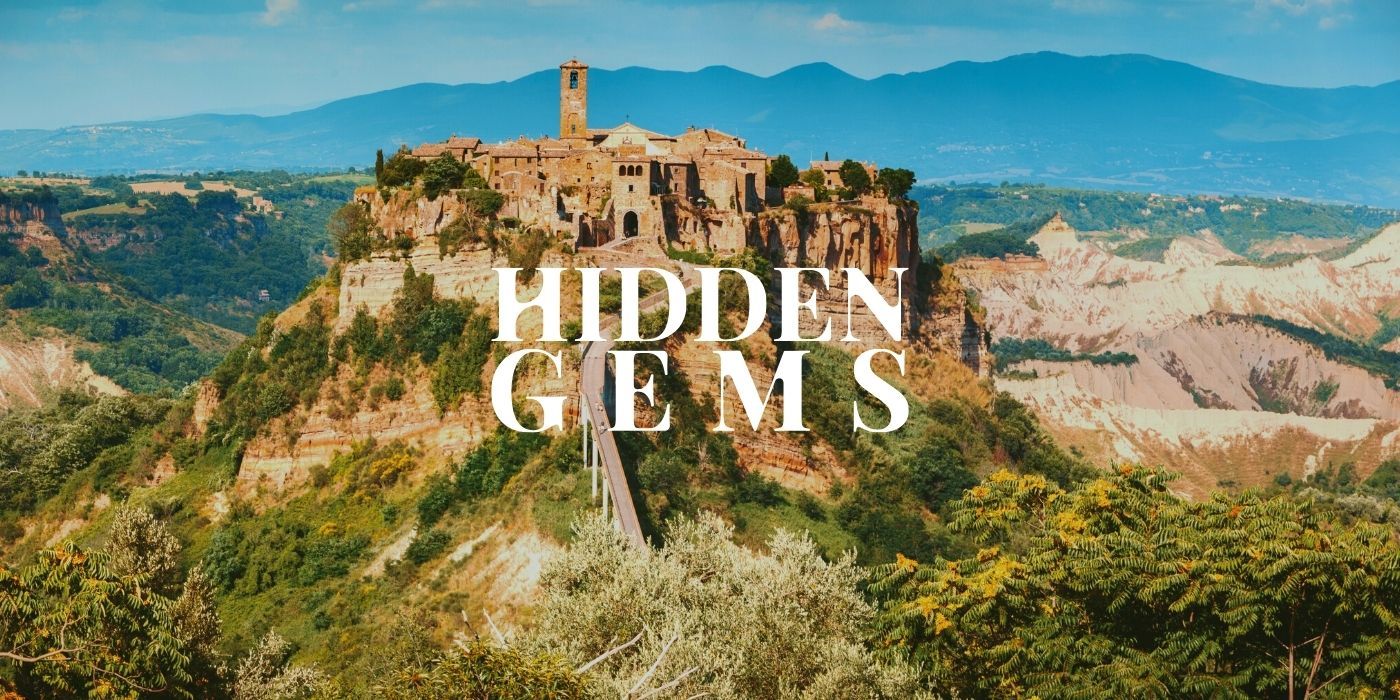Who hasn't dreamed at least once of living in another era? All of us, traveling with our imagination, have imagined exploring places and stories of the past (and like in the past), inspired by the discovery of ancient civilizations, by epic adventure novels, or perhaps simply by a film.
Well, if you want to make this dream come true by traveling for real, then there’s a truly iconic and special place that awaits you: it's Civita di Bagnoregio, a breathtaking village that seems hanging high up between the hills where time has stood still. Discover with us where is and how to get to the "dying town", as the writer Bonaventura Tecchi defined it, and what to see by venturing through its alleys to admire the beauty enclosed within these ancient walls.

Where is Civita di Bagnoregio

The village of Civita di Bagnoregio is located in the province of Viterbo, in northern Lazio, precisely within the Valle dei Calanchi in the middle of the vast territory known as Tuscia including also a large part of Tuscany and western Umbria.
Civita is a hilltop hamlet of the village of Bagnoregio, located further down the valley, and in addition to its historical and landscape wonders it is characterized by a curious feature: today it counts only 11 inhabitants! Despite this, over the years it has become a very popular tourist destinations, with a constant growth in the amount of visitors who every year decide to rediscover and enhance this beautiful place.
Discover Viterbo, the City of the PopesHow to get to Civita di Bagnoregio

The easiest way to get to Civita di Bagnoregio is certainly by road, whether by car or even by tourist bus.
In particular, starting directly from Viterbo it is possible to reach Bagnoregio in about 30/40 minutes following two different routes: the first, going for the so-called Strada Teverina (SP5) and SP6; or the second, following SR2 and SR71 near Lake Bolsena.
Starting from Rome, instead, the ideal would be taking the A1 motorway, exiting at Orte, then following the SS675 to Viterbo and continuing as indicated previously up to your destination (around 2 hours).
It is also possible to get to Civita di Bagnoregio starting from Perugia, following the SR220 and then the A1 motorway, or even from the main hinterland Tuscan cities, taking the A1 as well. In both cases it is a must to follow the exit for Orvieto, another splendid village to visit in Tuscia before continuing a little further south, following the SP12 and SP6, destination Bagnoregio (around 2-3 hours).
Discover the wonderful Tuscia on a tour starting from RomeWhat to see in Civita di Bagnoregio

Once finally reached the charming village of Bagnoregio, which we recommend you visit by delving into the heart of its alleys and small squares dedicating a splendid walk to it - in particular, remember to pass through Piazza Sant'Agostino to admire the Church of Annunziata and the monument of San Bonaventura - we are ready to discover what to see in the hilltop hamlet of Civita di Bagnoregio.
This village is truly one of a kind. Just think that its current urban plan exactly corresponds to the original one, dating back to around 2500 years ago, so to its very foundation by the Etruscans. Furthermore, both the aesthetics and the atmosphere of Civita di Bagnoregio have remained almost intact and unchanged from the Middle Ages to today, giving us a real experience that is close to what a journey through time would feel like. Let's go visit it now!
First of all, starting from the village downstream, you will have to walk across the panoramic bridge approximately 300 meters long that goes up to the top of the hill where the ancient Civita di Bagnoregio stands. This bridge, as well as being a very popular tourist attraction for its spectacular views (it's the perfect moment for a photo!), also represents Civita's only and very important physical communication with the rest of the world.
Once you reach the end of the bridge, the Portal of Santa Maria will be waiting for you to welcome you within the walls of the historic village. Once crossed the threshold, we are sure that you will experience absolute wonder: a maze of paved alleys will reveal itself before your eyes, enclosed between the ancient medieval houses and framed with the beautiful colors of the flowers and decorations embellishing this Italian jewel.
Reaching Piazza San Donato, the core of the historic village, we find ourselves in front of the namesake church in its Romanesque-Renaissance style. It is certainly the most important building in Civita due to its ancient history (the first traces of the church date back to the end of the Roman Empire), due to the massive presence of its bell tower which stands out over the roofs of the village dominating it from above, but especially for the little big treasures of sacred art it houses: among these, an enchanting 1400’s wooden crucifix stands out, the true protagonist of a solemn religious celebration on the occasion of Good Friday at Easter.
Among the other unmissable attractions of the historic village of Civita, there are the Geological and Landslide Museum (inside Palazzo Alemanni) and the remains of the birthplace of San Bonaventura di Bagnoregio, dating back to the 1200’s.
Discover Civita di Bagnoregio, the Italian most beautiful hilltop villageWhen to visit Civita di Bagnoregio

The village of Civita di Bagnoregio can be visited and absolutely enjoyed at any time of the year, but we recommend some special moments to enjoy beautiful experiences and immerse yourself even more in the culture and traditions of this village like a true local.
Let's start with the Palio della Tonna, a historical revival of the medieval jousts taking place on the first Sunday of June and the second Sunday of September; unlike classic rides, here the protagonists are not horses, but beautiful donkeys.
The middle of summer, between July and August, is characterized by the Civit'Arte festival: an entire month of events dedicated to art in all its forms, in particular music and theatre, to be experienced in the splendid setting of Civita di Bagnoregio. In particular, don’t miss the Tuscia in Jazz Festival with concerts, seminars and jam sessions of great music.
However, if you want to treat yourself to a touch of pure magic and visit Civita at Christmas, between the end of December and the beginning of January the whole medieval village hosts a wonderful live nativity scene to experience the emotions of the most electrifying holidays of the year from a closer perspective.
Why is Civita di Bagnoregio called the “dying town”?

We conclude our journey to this new hidden gem by telling you a little more about its iconic nickname. Civita di Bagnoregio is commonly known as the "dying town", a particular and melancholic name created by Bonaventura Tecchi to underline the condition of progressive abandonment and structural deterioration of the village.
In fact, the ancient tuff formation on which Civita is built has undergone a severe process of erosion over time due to the action of atmospheric agents, leading to a constant degradation of the structures and foundations of the town and putting it at serious landslides risk; with the consequence, obviously, of an almost total voluntary evacuation of the population who dwelled within these walls.
With the difficulty of guaranteeing safety and stability of the ground, a goal that can only be achieved through constant attention to the conditions of the territory through restoration and redevelopment works, today Civita di Bagnoregio is permanently inhabited by only a handful of people.
The status of "dying town", therefore, reflects the continuous struggle of the wonderful Civita di Bagnoregio for its survival and the conservation of its historical and cultural heritage. In this very important mission, quality tourism is key to make the absolutely unique beauty and charm of this extraordinary place available to visitors from all over the world.
About the author
Written on 16/03/2024




Alessandro Esotico
Get ready to set off on an exciting journey discovering Civita di Bagnoregio, the fascinating "dying town" hanging high up in the middle of Tuscia.